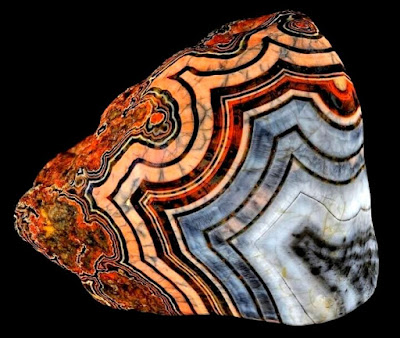How Do Agates Form?
 |
| lake superior agate |
What is an Agate?
Agates are semi-precious gemstones that are a variegated form of chalcedony (pronounced kal-sed’-nee), which is silicon dioxide in the form of microscopic fibrous quartz crystals. Agates naturally develop when an empty pocket inside a host rock fills in molecule-by-molecule, layer-by-layer as these microcrystals self organize to form concentric bands or other patterns.
The colors and arrangement of the microcrystals are influenced by changes in pressure, temperature, and mineral content that occur during the formation process. Unlike other gemstones, each agate is unique. Even slabs cut from the same specimen will vary in color and design.
How Do Agates Form?
Agates develop as secondary deposits in hollow cavities, called vesicles. Although they can form in all types of host rock, most of the world’s agates developed in ancient volcanic lava. When the continents were first forming, layers of molten lava pushed toward the earth’s surface through rift zone cracks, volcanoes, and other geologic events. Within the lava, there were pockets of trapped gases. Later, these gases escaped through cracks that formed as the igneous rock cooled and hardened, leaving hollow cavities. Other cracks and seams also formed when adjoining sections of lava cooled at different rates.
These empty cavities and seams filled with fluids rich in dissolved and suspended quartz molecules (silica), as well as other mineral impurities. When the silica concentration became supersaturated, it developed a gelatin-like consistency either throughout the pocket or in a layer that served as the active crystallization front. Over time, the silica molecules began to form miniature fibrous microcrystals that attached to the sides of the cavity or seam. During the filling-in process other mineral impurities collected at the inside of the chalcedony silica band, forming intervening and often contrasting bands. This pattern repeated until the entire vesicle was filled in, or until all the silica rich solution was used up. If there was the proper balance of silica and mineral impurities, then the entire cavity filled with alternating bands. If there was an insufficient quantity of mineral impurity or if the pressures and temperatures changed, the cavity completed filling in with macrocrystalline quartz, or another form of silica.
 |
| Fairburn Agate, credit: Tom “Captain Tenneal” Shearer |
 |
| Thin slice of Agate |
The original article was written by Karen Brzys , Gitche Gumee Museum
